Pick of the Brown Bag
September 4, 2019
by
Ray Tate
Welcome to the Pick of the Brown Bag. My name is Ray Tate, and we've got lots of comic book reviews to get through because almost everything was noteworthy. Our contenders this week include Fantastic Four, The Future Foundation, the Ghost Spider Annual, Harley and Ivy, Immortal Hulk, Red Range Pirates of Fireworld, Supergirl, Superman Up In the Sky, Vampirella and Red Sonja and The Web of Black Widow. Time keeps on slipping? Check me out on Twitter: #Pick of the Brown Bag.
Although you may have come in late for Red Range Pirates of Fireworld it’s not necessary that you know the story unfolding elsewhere. Red Range is a Hammeresque take on Edgar Rice Burroughs with an African-American twist. The story begins on a quest for food.
This leads to an adopted father and son moment that introduces the second character Caleb Range.
He’s called Red Range due to his penchant for wearing a red mask.
The name alludes to westerns, but Pirates of Fireworld is steeped more in Civil War racism, though not in the way you think. Caleb and Turon are wanted by slavers from "The World Up There." Damned if you don't think of Land of the Lost. Though Red Range benefits from a bigger budget.
White soldiers from different times make their presence known.
A flying ship alights.
The wonderment of it all fades when you realize that these fancies are nevertheless in the service of slavery.
Although it’s not quite as simple as black and white, and the book by Keith Lansdale is better for it.
New Vampirella writer Jordie Bellaire surprises right from the get-go. He takes Vampirella back to her 1969 origin. V states that she spent “a little over a year” on earth in Brooklyn. So, her arrival and the start of her adventures occurred in 1967.
So, Vampirella heads to Russia to investigate as the journalist Ella. In a scene loaded with friction, V first grills a representative for the Russian space program. She then moves on to the first hand stories of the locals and finds Sherlock Holmes' adage to be true.
Bellaire's emphasis on the Russian space program however suggests involvement. The possibilities will become apparent to any astute reader once the big reveal occurs at the cliffhanger. Think the horribly underrated Philadelphia Experiment.
In the end, V decides to take a hands-on approach, and instead of a monster, she finds something else entirely.
It’s elegant how Bellaire’s plot folds so smoothly into this introduction of Vampirella, Red Sonja and their friendship. I also like the Russian setting as a change and a friendlier cast of Russians than we're used to seeing.
Vampirella doesn’t usually posit the existence of a multiverse. Nearly all of her adventures, team-ups and duels fit well within her relatively loose continuity. Even the rewrites of her history can be glossed over or embraced without disturbing the still point of Vampirella being a blood-sucking alien from Drakulon.
Bellaire's story however feels different. Vampirella though in character also seems different. Sharper and more at ease with herself. The Warren Vampirella often appeared as an innocent, and this may have something to do with the romantic/Gothic artwork in the magazine.
Vampirella here actively takes the role of detective. Artist Drew Moss consistently bestows canny expressions that remind one of the late Elizabeth Montgomery of Bewitched. A totally appropriate homage.
A natural disaster snuffed out the planet Krypton, or so we thought. Turns out a cabal of aliens hired Rogol Zaar to kill it. This pissed off one the last survivors.
Supergirl wanted revenge. She intended to hunt down Rogol Zaar and make him pay. This aim demanded that she leave earth and travel the spaceways. Her cousin Superman wouldn’t stop her. Instead, he gave her the gift of Krypto to watch her back, and stop her from digging a second grave.
For the most part, Marc Andreyko’s Supergirl did exactly what she set out to do. Kara used Zaar’s “magic” battle axe to track Zaar through the cosmos, having adventures on the way: outwitting the Green Lantern Corps, meeting the Omega Men, kissing Starfire’s brother.
Supergirl succeeds in eventually battling Zaar, wresting his axe from him and beating the living crap out of him as well as his employer, a crystalline being that she shattered into a million pieces.
Thanks to Krypto, Kara restrains herself. Though I must add, Kara restrained is still a force to be reckoned with.
Supergirl mostly worked independently from the other Superman Family titles. In the last issues of the arc, she teamed up with her cousins Superman and Jonathan Kent the new Superboy.
Presumably, she shares the action in Superman and Action Comics written by Brian Bendis. I do not read Bendis. Historically, such selectivity leads to confusion and a lack of quality in the overall consistency. Supergirl eschews this dilemma through Andreyko’s superb craftsmanship and the presence of series artists Kevin Maguire, Eduardo Pansica and Julio Ferreira.
Pansica and Ferreira illustrates a double-splash page DC’s alien races before Maguire returns with another doublet of the newest version of the Legion.
That story within Supergirl is Kara-centric. Andreyko spotlights Kara’s emotions, originally churning like thunderclouds but now quelling.
That said. If you wish it, you can in fact discern the overall story just through Andreyko’s manipulation of the plot.
That said. If you wish it, you can in fact discern the overall story just through Andreyko’s manipulation of the plot.
Supergirl opens at the tail end and seems to duck in and out of the Superman titles. For example, Zod apparently joined The Superman Family in their battle against Rogol Zaar.
Supergirl was Zod-free up to this moment. It doesn’t take rocket science to figure out that Zod threw in with the Els out of a sense of Kryptonian kinship.
The Thanagarians capture the Kryptonians. Andreyko already foreshadowed their involvement with an official from Thanagar being part of the cabal. If you didn’t know that, or forgotten, it’s still no surprise to see Thanagar involved.
Thanagar is known for its police force, with the Silver Age Hawkman and Hawkgirl being their most famous officers. Don’t over think it. Just stay with pre-Crisis terms when encountering Thanagar at any time in the DCU. You’ll feel better about yourself.
Listen. You’re not here any of that. You’re here for the story of a Girl and her Super-Dog. That part is solid gold. How the whole shebang works out isn’t important, but you get a good idea anyway.
Communications. In Star Trek, sub-space relays festooned across the galaxy beam messages amazingly long distances adjusting for time. In DC Comics, not so much.
Superman Up In the Sky is a goofy lark about Superman getting bored while waiting for his call to go through to Lois Lane on twenty-first century earth. Remember, space and time are linked. While waiting, Superman imagines the worst case scenario and kills his wife over and over again in his mind. Some moments are plausible. The others over the top.
Seriously. I’m no expert, but I think Aquaman is going to have a lot of explaining to do should Lois Lane be gutted by a shark. I mean. How would that conversation go?
“You see, Superbro. It’s the circle of life.”
The more dramatic tale is an issue of DC Comics Presents that got caught in a wormhole. In the second story, Superman meets Sgt. Rock and Easy Company.
Yeah, this is pretty much what you expect. An amnesiac Superman joins the War as Clark Kent. In a critical, rousing moment that Andy Kubert, Sandra Hope and Brad Anderson milk for all their worth, Clark regains his memory. The recall leads to the showstopper of Superman beating on Nazis. And not being gentle about it.
Immortal Hulk and Gamma Flight vs General Fortean and Shadow Base. It’s the big dukearoo where the art by Joe Bennett, Ruy Jose, Belardino Brabo and Paul Mounts edges out the writing of Al Ewing just a tad.
Some of the things that Ewing recalls from Hulk Family stories of the past is Rick Jones’ singing career. Oh, yeah. He did, back during the Captain Marvel tales. Rick Jones and Mar-Vell shared their existence through a device called the Nega Bands.
She-Hulk’s arch-nemesis Titania expresses deadpan wit as she finds herself fighting along side of the Hulk. Crusher Creel takes it in stride. Crusher Creel is one of the oddest evolutions in Marvel history. Nobody could have predicted that this Stan Lee and Jack Kirby bad guy who hassled Thor could turn into a credible hero.
Doc Samson on the other hand was designed to be the hero of the tale. Other writers had other ideas. Given Doc's dickish history, his ploy to save the Hulk should be surprising. It isn't. Al Ewing redeemed Doc Samson.
Redemption isn't his alone. Shadowbase's Dr. McGowan owns up to her part in Fortean’s fever dream of Gamma-Monster-Soldiers and the finale. Always there's this underlying idea of just following orders as an excuse, but to Ewing and the Hulk, that's just a flimsy permission and cannot be accepted. McGowan exhibits remorse and demonstrates mercy. For that she's spared. For now. Not so General Fortean, for in his zeal to kill the Hulk, he unleashes something far worse at the cliffhanger.
She-Hulk’s arch-nemesis Titania expresses deadpan wit as she finds herself fighting along side of the Hulk. Crusher Creel takes it in stride. Crusher Creel is one of the oddest evolutions in Marvel history. Nobody could have predicted that this Stan Lee and Jack Kirby bad guy who hassled Thor could turn into a credible hero.
Doc Samson on the other hand was designed to be the hero of the tale. Other writers had other ideas. Given Doc's dickish history, his ploy to save the Hulk should be surprising. It isn't. Al Ewing redeemed Doc Samson.
Redemption isn't his alone. Shadowbase's Dr. McGowan owns up to her part in Fortean’s fever dream of Gamma-Monster-Soldiers and the finale. Always there's this underlying idea of just following orders as an excuse, but to Ewing and the Hulk, that's just a flimsy permission and cannot be accepted. McGowan exhibits remorse and demonstrates mercy. For that she's spared. For now. Not so General Fortean, for in his zeal to kill the Hulk, he unleashes something far worse at the cliffhanger.
The Future Foundation consists of two members of the Power Pack, Moloids, Dragon Man, a Wakandan whiz kid and a clone of the Wizard, as well as some amphibian species and a few floating heads here and there. They’re on the hunt for pieces of the Molecule Man, a former villain turned protagonist. To that end, they infiltrate a jail with the help of Yondu from The Guardians of the Galaxy.
Writer Jeremy Whitley introduced Marvel's Takron-Galtos. This isn't an ordinary prison. It's a penitentiary for super powered individuals. Naturally, they take the precaution of nullifying the abilities through the typical science fiction device of suppressor collars and such. These plans fall by the wayside when Alex Power thinks that he's met Reed Richards. In fact, he encounters the fellow on the cover.
That is the Maker, a Reed Richards alternate from another universe. He's joined by fellow inmates selected for their murderous intent.
That's all right though because Julie Power discovers an even better surprise in her cell. The surly girl-prisoner she tried to get along with in the debut turns out to be another visitor from another universe. Only this stranger is one of the good guys, perhaps a little worse for wear.
Whitley impresses me not only with is character sleight of hand but also by cutting to the chase. Five or ten years ago, the Maker would have hid his identity for an interminable amount of time while the supposed smart guys in the room looked the other way. The Future Foundation quickly discerns the Maker's true identity, and a fight breaks out by the issue's end.
Our story opens at the National Air and Space Museum, where the FF dedicate the newest exhibit.
The very ship in which they crashed. It inspires the Look of Love in Reed Richards.
And post traumatic stress in his best bud Ben Grimm. At the museum, Slott introduces the two astronauts that were supposed to go up with Reed and Ben.
Remember. The FF went forward early with the mission by themselves and without sanction from the government.
Writer Dan Slott once again employs the brilliant original movies to draw some inspiration from. In the film Chris Evans served under Ben Grimm, and so it recapitulates here, with some added power under Sue’s support.
This is where Slott brings insight into the origin of the FF. He concentrates on why the quartet did what they did in the first place.
He characterizes the group as a family of daredevils, which is very much in keeping with what Jack Kirby and Stan Lee conceived. Slott emphasizes the Four’s common sense of exploration in scenes transcendently captured by Paco Medina and colorist Jesus Aburtov.
Though the Marvel villain Arcade crossed swords with all sorts of superheroes, he’s never gotten over the fact that Spider-Man and Captain Britain beat him first in Marvel Team-Up. He just cannot let that defeat go. That’s why Gwen Stacy finds herself in the confusing Murderworld.
Gwen was just minding her own business, swinging back home when she drops on a trigger that sends her down the rabbit hole meant for Spider-Man.
Vita Ayala produces a highly comical adventure. A damsel in distress leads Gwen onto the games of Murderworld, and within she finds a few familiar faces.
The key is that Gwen suffers none of the psychological borne hesitance that Arcade hopes to instill in Spider-Man. Arcade’s not actually present. Else he would have probably not bothered. When he gets the recording, I imagine he’ll be just as confused as Gwen.
This is all fun, but what Ayala puts into the story that makes the Annual worth buying is an introspective narration that you just don’t see coming.
You’re just breezing along with action-packed artwork from Pere Perez and Rachelle Rosenberg, enjoying the crack-wise and Gwen pasting Arcade’s robots. Then the narration evolves into a philosophy class that’s not bad to intend.
For those who came in late, Natasha Romanoff is the Black Widow. She debuted in the 1960s as an Iron Man villain. Truth be told, she wasn’t much more than a stereotypical Russian femme fatale.
She reformed to become uniquely cool, one of the oldest and steadfast members of the Avengers and the cinematic Avengers’ Batman.
During the crossover Secret Empire, the doppelgänger of Captain America killed the Black Widow. Science resurrected Natasha with her memories intact. That left Nat with a serious mad on that she explored on the Marvel island of Madripoor thanks to Jen and Sylvia Soska.
Upon opening the newest Black Widow miniseries Web of Black Widow, you will be struck by the excruciatingly gorgeous artwork by Stephen Mooney and colorist Triona Farrel. The art contrasts that of the Soskas collaborator Fabiano.
However, there are similarities as well. Such as an adherence to a two page splash depicting Natasha in action.
Doctor Who’s Jody Houser also draws from the previous mini-series. Black Widow is still angry. Only this time, she’s angry at the actions she took in her past.
The differences between characterization are subtle. In fact these subtle differences arise from Houser keeping Natasha firmly in the civilized world of Marvel Comics.
Houser juxtaposes the Black Widow’s history in flashbacks, but these are thankfully judicious. Black Widow’s history, the retro-plants and her deconstruction are well known. Belaboring the point would be detrimental.
Houser instead uses the ubiquity of Black Widow’s history to her advantage. For example, when we see Natasha as a girl, she’s engaging in the ballet. A facade of the Red Room. There’s no exposition. Houser knows we know this. She lets the artist depict.
Created by Paul Dini, Bruce Timm and face facts Arleen Sorkin, the Joker’s henchwench Harley Quinn took on a life of her own. She debuted in DC Comics during the post-Crisis, and made it again in the New 52. Here, Harley finally freed herself of the Joker’s influence and rekindled a cartoon romance with Poison Ivy. These events however occurred in her off-tangent title book by Jimmy Palmiotti and Amanda Conner.
Poison Ivy’s official reintroduction arose in The Birds of Prey. Writer Duane Swierczynski took the novel choice of debuting Ivy as a hero. That persona stuck. She remains ever more a flawed hero rather than an outright villain.
Meanwhile over in Suicide Squad, Harley still insane, in love with the Joker, and an antagonist. As time went on and the Suicide Squad film became successful, Harley turned more noble. By the time she guests in Aquaman you really can’t say she’s a villain.
Tom King got Harley and Ivy together, “for reals.” So their relationship became canon to Batman. He also wrote Ivy’s demise.
As well as her rebirth in Heroes in Crisis.
Poison Ivy is now a sentient plant like Alec Holland aka Swamp Thing.
Jody Houser takes over the next chapter in the lives of Harley and Ivy. Fans may be a little disappointed in the depictions of their relationship, back to subtext. That said. Houser includes moments where you can tell that Harley and Ivy are in love.
Though this can be dismissed as mere affection, Harley simply must love Ivy. Because she never abandons her, for better or worse.
Ivy’s having a little bit of a problem with her new life. Houser connects the solution to “The Year of the Villain.”
Strange DC didn’t include that annoying banner that’s on the other books that don’t actually focus on the Big Stupid Event. In this story, Lex Luthor’s gifts are vital to Ivy’s health.
Helllloooo Plant Nurse!
Ahem. That is art by Adriano Melo and Mark Morales highlights an appreciation for the human form and realistic expression.
Harley feels a little miffed that Lex didn’t deliver a gift to her, but she actually doesn’t realize that Ivy’s gift is her gift. A healthy Ivy means a happy Harley. Of course, it’s Lex Luthor. There must be strings attached, but the question. Do those strings radiate from a villain from Ivy’s past?
Houser’s take on Harley and Ivy is more amusing than madcap and more science fiction than straight up drama. This is a good setup issue. Houser emphasizes Ivy’s heroic ties, and introduces a change in Harley that derives from Conner and Palmiotti’s written depth.




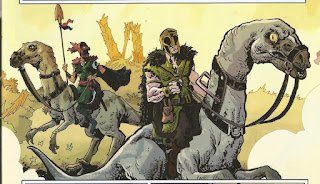










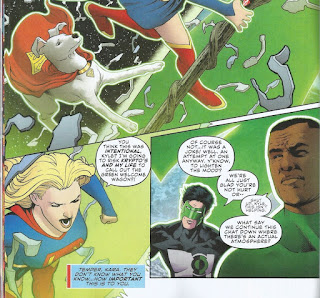












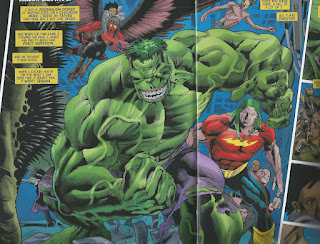






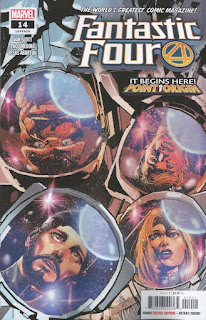





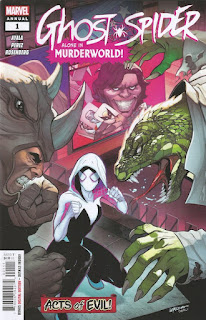
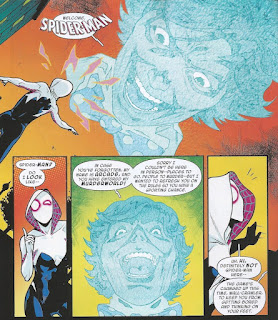









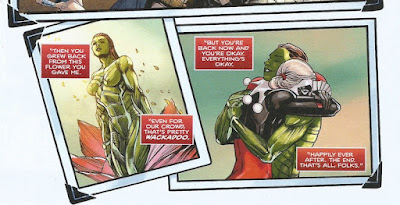



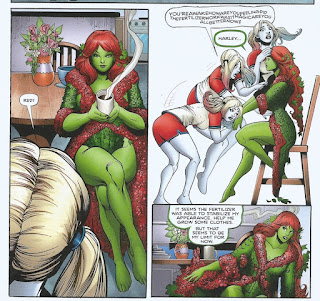
No comments:
Post a Comment